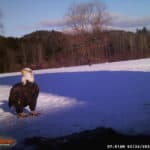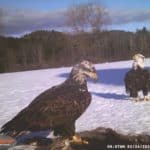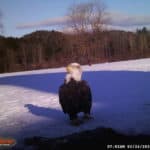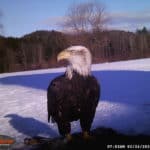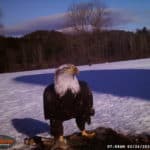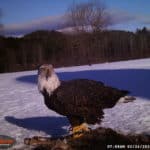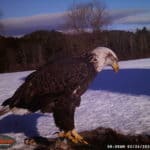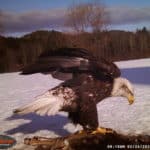
Kim Kendall is a classmate and friend of mine. This past January I paid him a visit. When I walked in, Kim said, “The eagles are out there today.”
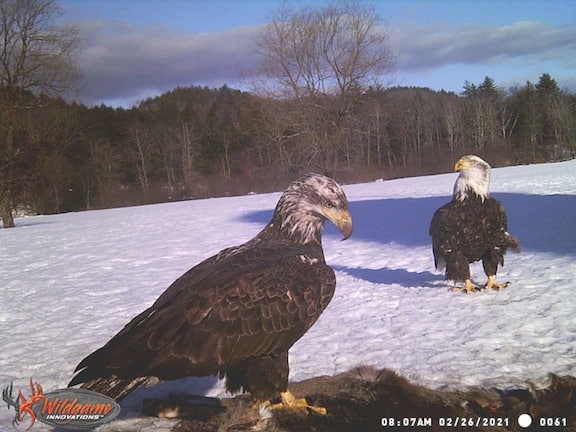
I got up to look. Sure enough there was a bald eagle in his field.
Two Vermont game wardens, Asa Sargent and Kyle Isherwood, bring Kim roadkill deer. They drag them out in Kim’s field, maybe 200 feet from the house. Don’t get excited; these are deer too mangled for human consumption. There are benefits in disposing the carcasses this way.
A deer lying off the side of the road will attract all species of animals that feed off the carcass – coyotes, foxes, crows and ravens, raccoons, and bald eagles. Here they can be hit by a car. By moving the carcass away from the road into the field, any threats from humans are eliminated. We can live our lives and the critters can live theirs.
Several times this winter when I’ve been at Kim’s, I’ve tried to get photos of the eagles. These eagles have excellent eyesight. Even if I carefully sneak up to the kitchen window, the eagles would see me and fly away.
Scott Kendall, Kim’s nephew, set up his game camera nearby. Scott got some great photos, which he emailed to me. The photo with this article is one of them. These are beautiful photos. Scott’s game camera is much better than mine.
I don’t remember Vermont having bald eagles in residence when I was a kid. It was in the 1980s, as I recall, when this majestic bird was reintroduced, at least in our area. I remember seeing my first eagle on Route 5, north of the toll bridge in Springfield. In years since, their numbers have increased.
You’ll notice their heads and tails are not pure white. The head is white but has mottled brown feathers intermixed. It takes up to five years for an eagle to reach maturity, at which time their head and tail turn pure white. The eagles feeding at Kim’s are mostly immature birds – although he has seen a couple adults. One day Kim had five eagles present.
The female eagle is larger than her male counterpart with a wingspan of six to seven feet. They are said to mate for life. The female will weigh about 12 pounds and the male about nine pounds. It is not uncommon for an eagle to live 20 years in the wild.
Along with the eagles, crows and ravens are regular diners. At night coyotes and foxes come in to feed. They drag off large bones to dine in privacy.
Kim and I often talk about the natural world and life’s cycle. Kim told me that a deer carcass will completely disappear in a week or so – bones and all. So far this winter the game wardens have brought in three deer carcasses.
The cycle
When the birds and animals have eaten their fill, they return to the woods where they download in the woods. This benefits plants and trees providing a natural fertilizer. Bones too large to be eaten are scattered throughout the woods. These bones are eaten by insects. Nothing is wasted. Hard to be any greener or more natural, I say.
Kim is from a long line of farmers and an old hippie. Sometimes I ask Kim a question why this or that works. Kim will shrug his shoulders and say in his Vermont drawl, “Weeell, I don’t know, but it does.” He doesn’t need to know why it works. What he knows has been passed down from one generation to the next.
I was at Kim’s this past weekend. I looked out the kitchen window. Nothing was left of the carcasses, but I noticed a new bluebird house on a post. Kim told me a bluebird won’t move into a dirty house so you have to clean out the old nest every year, and that can be problematic.
Mark Dutton made the new birdhouse. Mark made it to easily open with hinges for cleaning. Kim says the bluebirds are back. Kim has also seen a phoebe. They like to build mud nests in his barn. Nature is welcome as long as they follow Kim’s rules.
This week’s old saying: “If the farmer fails, all will starve.”
